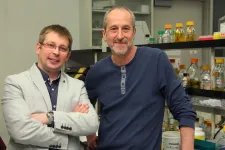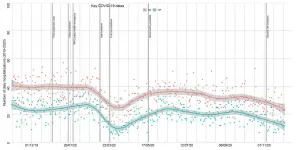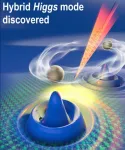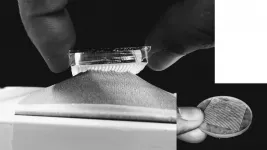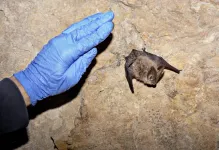(Press-News.org) New high-resolution structures of the bacterial ribosome determined by researchers at the University of Illinois Chicago show that a single water molecule may be the cause -- and possible solution -- of antibiotic resistance.
The findings of the new UIC study are published in the journal Nature Chemical Biology.
Pathogenic germs become resistant to antibiotics when they develop the ability to defeat the drugs designed to kill them. Each year in the U.S., millions of people suffer from antibiotic-resistant infections, and thousands of people die as a result.
Developing new drugs is a key way the scientific community is trying to reduce the impact of antibiotic resistance.
"The first thing we need to do to make improved drugs is to better understand how antibiotics work and how 'bad bugs' become resistant to them," said Alexander Mankin, professor of pharmaceutical sciences at the UIC College of Pharmacy and co-author of the paper.
Mankin and his colleague, Yury Polikanov, associate professor of biological sciences at the UIC College of Liberal Arts and Sciences, have been studying the mechanism of action of one of the most popular types of antibiotics used in the clinic today -- macrolides.
"Macrolides are among the most successful antibiotics that are commonly used to treat infections that spread in the community -- people get macrolide antibiotics, like azithromycin, for example, all the time," said Polikanov, the corresponding author of the paper. "Macrolides work by entering bacteria and binding to the ribosomes, the protein synthesis machine of the cell. Once bound, the drug prevents ribosomes from making new proteins, thereby stopping bacteria from growing and replicating. However, resistant bacteria change their ribosomes so that the drug cannot bind to them anymore."
Through years of partnership between their two labs, the UIC researchers were able to understand how macrolides bind to the ribosome, how bacteria respond to macrolides and how they become resistant to these commonly used drugs. They also learned how to capture high-resolution images of the ribosomes invaded by antibiotics.
"We compared the hi-res structures of the ribosomes from sensitive and resistant bacteria and noticed that a water molecule that is needed for the tight antibiotic binding was not present in the ribosomes from the drug-resistant bugs. In the ribosomes from the drug-resistant bacteria, there was simply no room for this water molecule," Polikanov said.
The water molecule, the researchers found, acts as a bridge between the ribosome and antibiotic. When resistant bacteria change the chemical makeup of their ribosomes, this bridge between the ribosome and the drug cannot be built. While the scientific community has long guessed that differences in the structures of the sensitive and resistant ribosomes were important -- why these changes prevent drug action was previously unknown.
"This study offers the first convincing explanation of why macrolides are unable to bind to ribosomes of the resistant bacteria," Mankin said.
"We are very much excited by this discovery," Polikanov said. "Because we now know how exactly macrolide antibiotics interact with their target, the ribosome. This discovery is important because it will inform and facilitate the development of new antibiotics that do not need this water molecule for binding. There is a huge demand for such drugs that are able to kill even those bacteria that became resistant to the currently used drugs."
INFORMATION:
Co-authors on the paper are Maxim Svetlov, Egor Syroegin, Elena Aleksandrova of UIC, Gemma Atkinson of Umea University, and Steven Gregory of the University of Rhode Island.
This work was supported by Illinois state startup funds, the National Institutes of Health (R21AI137584, R01GM132302, R35GM127134, and R01GM094157), the United States Department of Agriculture's National Institute of Food and Agriculture (Hatch Project 10160130), and the Swedish Research Council (201504746 and 201901085).
Data analysis is revealing a second sharp drop in the number of people admitted to hospital in England with acute heart failure or a heart attack.
The decline began in October as the numbers of COVID-19 infections began to surge ahead of the second lockdown, which came into force in early November.
The findings, from a research group led by the University of Leeds, have been revealed in a letter to the Journal of the American College of Cardiology.
The decline - 41 percent fewer people attending with heart failure and 34 percent with a heart attack compared to pre-pandemic levels ...
The human brain has about as many neurons as glial cells. These are divided into four major groups: the microglia, the astrocytes, the NG2 glial cells, and the oligodendrocytes. Oligodendrocytes function primarily as a type of cellular insulating tape: They form long tendrils, which consist largely of fat-like substances and do not conduct electricity. These wrap around the axons, which are the extensions through which the nerve cells send their electrical impulses. This prevents short circuits and accelerates signal forwarding.
Astrocytes, on the other hand, supply the nerve cells with energy: Through their appendages they come into contact with blood vessels and absorb glucose from these. ...
AMES, Iowa - Even if you weren't a physics major, you've probably heard something about the Higgs boson.
There was the title of a 1993 book by Nobel laureate Leon Lederman that dubbed the Higgs "The God Particle." There was the search for the Higgs particle that launched after 2009's first collisions inside the Large Hadron Collider in Europe. There was the 2013 announcement that Peter Higgs and Francois Englert won the Nobel Prize in Physics for independently theorizing in 1964 that a fundamental particle - the Higgs - is the source of mass in subatomic ...
BROOKLYN, New York, Tuesday, January 19, 2021 - The World Health Organization END ...
WASHINGTON, January 19, 2021 -- A Velcro-like fastener with a microscopic design that looks like tiny mushrooms could mean advances for everyday consumers and scientific fields like robotics.
In Biointerphases, published by AIP Publishing, researchers from Wageningen University in the Netherlands show how the design can use softer materials and still be strong enough to work.
Probabilistic fasteners work, because they are designed with a tiny pattern on one surface that interlocks with features on the other surface. Currently available fasteners, like Velcro and 3M, are called hook and loop fasteners. That design requires harder, stiff material, which ...
Even prior to the pandemic, burnout among health care professionals was a pervasive public health concern, with END ...
Large-scale land acquisitions by foreign investors, intended to improve global food security, had little to no benefit, increasing crop production in some areas while simultaneously threatening local food security in others, according to researchers who studied their effects.
The END ...
CORVALLIS, Ore. - Tiny amounts of gender bias in employee hiring decisions contribute to concerning rates of discrimination and productivity losses that together represent significant costs, financial and otherwise, for employers, a new study from Oregon State University has found.
Gender bias is a subtle, unintentional preference for one gender over the other. Despite significant efforts to reduce bias in hiring over the last several decades, it continues to persist and pose potential problems for companies, said Jay Hardy, an assistant professor of management in OSU's College ...
BOZEMAN, Montana (January 19, 2021) - A four-year study recently published in Ecology and Evolution concludes that the fungal disease, white-nose syndrome, poses a severe threat to many western North American bats.
Since it was first detected in 2006, white-nose syndrome has killed millions of bats in eastern and central North America. The spread of the fungal pathogen that causes white-nose syndrome in hibernating bats has reached several western U.S. states, mostly likely through bat-to-bat spread, and is presently threatening western species.
Bats with white-nose syndrome have fungus growing on their nose and wings, as the name implies, but the fungal infection also triggers a higher frequency of arousals from hibernation. ...
Anyone who has tried and failed to meditate knows that our minds are rarely still. But where do they roam? New research led by UC Berkeley has come up with a way to track the flow of our internal thought processes and signal whether our minds are focused, fixated or wandering.
Using an electroencephalogram (EEG) to measure brain activity while people performed mundane attention tasks, researchers identified brain signals that reveal when the mind is not focused on the task at hand or aimlessly wandering, especially after concentrating on an assignment.
Specifically, increased alpha brain waves were detected in the prefrontal cortex of ...
